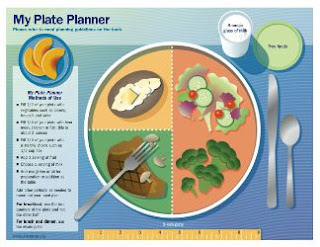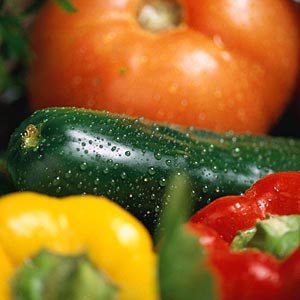Thursday, February 21, 2008
Organic Food for Thought
The New Yorker has an interesting article by Michael Specter this week about eating local and measuring the carbon footprint. He also gave an informative interview to Terry Gross of NPR's Fresh Air that's worth a listen.
Monday, February 18, 2008
Pepper Plaque Preventer

February is Heart Month.
One healthy-heart veggie is currently cheap, cheap, cheap here in Chicago. Red peppers were a mere $0.69/lb this Saturday at one of my favorite produce marts, Fresh Farms at 2626 W Devon Ave. At those prices, I had to stock up. They’re currently being stored in my refrigerator where they should keep for a week.
Not only are sweet bell peppers a great source of vitamins C and E, provitamin A, and carotenoids, one study showed that that the antioxidants in sweet bell peppers may reduce the build-up of plaque. How? When you cook foods containing cholesterol, like dairy, eggs, meat, poultry and fish, the cholesterol in these foods can oxidize, creating harmful by-products that may lead to the build up of plaque. Adding antioxidant-rich bell peppers to the mix reduced the creation of those harmful by-products.
Of all the bell peppers, red peppers appear to have the highest levels of the phenolic antioxidants beta-carotene, capsanthin, quercetin, and luteolin. To me, they're also the tastiest.
One lazy way to add red peppers to your diet is simply to slice them up and take them to work with you as a snack.
One fun way to add them to your diet is this red pepper shrimp recipe adapted from Madhur Jaffrey’s Cookbook by Madhur Jaffrey. Serve with rice or other grain of your choice.
To make this recipe super fast, use frozen uncooked peeled and deveined shrimp. All you have to do is give the frozen shrimp a quick rinse to remove excess ice and then toss them into the pan. They'll defrost while sauteing.
Red Pepper Shrimp
Serves 4
1 ½ lb medium-sized shrimp, peeled, deveined, and rinsed
1 sweet red pepper, seeds and white pith removed, coarsely chopped
1 small onion, coarsely chopped
10 small raw cashews or 7 roasted macadamia nuts
1 T canola oil
1 teaspoon brown mustard seeds
2 cloves garlic, finely minced
salt to taste
½ tsp cayenne pepper
1 tsp paprika
Puree the red pepper, onion, and nuts in a food processor.
Heat 1 T oil in a wok or non-stick pan over a medium-high heat. When hot, put in the mustard seeds and cover (to prevent the seeds from flying all over your kitchen). Once they start popping, remove the cover and add the garlic. Stir once and add the shrimp. Saute until shrimp turns barely pink and remove, leaving oil behind.
Reheat the pan and put in red pepper paste. Saute for 4-5 minutes until paste appears dry. Add salt to season (about 1/4 tsp), cayenne, and paprika. Taste and adjust seasonings if needed. Stir once and then return the reserved shrimp with any liquied to the pan. Lower heat and cook for another minute. Serve immediately.
Enjoy the red pepper bounty.
Thursday, February 14, 2008
Honorary Special Occasion Veggie

When you think of chocolate this Valentine’s Day, you may think of love and sweetness. You may even think of it as high in flavanols like catechin, epicatechin, and proanthocyanidin, antioxidants that may protect your blood vessels and reduce blood pressure.
But do you think of fiber?
Lindt’s Peruvian Extra Dark Chocolate, my current favorite, has 6g, yes 6g, of fiber per four square serving. And only 6g of sugar!!
For those of you counting carbs, if a serving has more than 5g of fiber, half the fiber grams are subtracted from the total carb grams. That means the Peruvian chocolate counts for only 6g of carbs per serving.
Chocolate may not be an all-you-can-eat indulgence but healthy eating doesn’t have to go completely out the window.
Simply read your nutrition labels carefully. Fiber and sugar content varies. While sugar on a nutrition label can include both naturally occurring and added mono- and disaccarrides, the sugar in chocolate is all added sucrose. In the case of chocolate, when you look at the amount of sugar on a label, divide the grams of sugar by four to visualize how many teaspoons of sugar it provides. Just something to ponder.
In any case, savor the flavor and enjoy responsibly.

Wednesday, February 13, 2008
Keeping Carbs Simple

Really simple -- only plant foods have carbs. Oh, and milk has carbs. Consider milk a secondary plant food since the cow makes it from the grass she eats.
Without glucose, a carbohydrate, we die. Our brains run on glucose.
Carbohydrates are sugars, fibers, and starches made up of hydrated carbons (get it? carbo-hydrates?) or carbons attached to water molecules.
The most basic carbs are single-unit sugar molecules called monosaccarides, such as glucose, fructose and galactose (and pictured below, mannose, a second-tier monosaccaride). They have the same chemical formulas but different arrangements, conformations, leading to different responses in our bodies.

The simple sugars, two-unit sugar compounds called disaccarides, include:
Sucrose (table sugar) = Glucose + Fructose
Lactose (milk sugar) = Glucose + Galactose
Maltose (grain sugar)= Glucose + Glucose
Starches are considered complex carbs because they contain more than two sugar units. Starches are essentially chains of glucose.
For us to use the energy in carbs, our digestive system breaks down carb compounds to their single-unit bases. Carbs enter our bloodstream as glucose, fructose, or galactose. When they're not broken down, carbs stay in our digestive system until we eliminate them. Sometimes that's good as with fiber. Sometimes that's bad as with lactose deficiency.
Why do you care? A lot of people talk about weight control connected to insulin and insulin resistance. To understand insulin and insulin resistance, you have to understand carbs. To understand veggies -- and all the other plants and how to eat a balanced diet, you have to understand carbs.
To keep it simple, different carbs are digested at different rates. This is the principle behind glycemic-based diets. Insulin is related to the amount of glucose, not galactose or fructose, in the blood. Increased insulin resistance is connected with increased waist circumference.
Stay tuned for more.
Mobile Dieting
Fortunately, a new service is bringing the info from the big chains directly to your cellphone. Test drive it for free. It's not perfect but what in life is. Plus, you'll see what happens when veggies go bad. Just enter artichoke and see what I mean.
If you need the comfort of a bigger computer screen and want to see all of your options at once, BD Diabetes has a great PDF fast food guide.
A Plate Half Full

The plate method is all about the veggies. Veggies help increase the portion size of your meals without overloading the meal with carbs and calories.
People with diabetes control carbs by counting carb servings. A serving of carbohydrates equals 15g of carbohydrates.
Mind you, not all veggies are created equal within the plate method. For both carb and weight control, veggies are grouped into starchy veggies and watery veggies.
Starchy veggies include potatoes, sweet potatoes, corn, peas, parsnips, plantains, and yucca. These veggies are high in carbohydrates and calories so they need to be portion controlled. A single carb serving is 1/2 cup. Starchy veggies take up a quarter of a plate.
Winter squash and pumpkin are also starchy but still kind of watery so their carb portion size is one cup.
If you eat a starchy veggie, you shouldn't have any other starchy foods at that meal like bread, pasta, or rice.
Watery veggies are all the other veggies like greens, broccoli, carrots, beets, cauliflower, tomotoes, cucumbers, etc., etc. These veggies are low in carbs and calories and can essentially be eaten without restriction as long as they are not swimming in high-calorie fat-based sauces or dressing. You have to eat 1 1/2 cups of watery veggies to equal the carbs in 1/2 cup of starchy veggies.
Fill up half of your plate with these veggies. They'll fill you up while adding a lot of nutrients and very few calories.
The last quarter of your plate is your protein -- 3 oz of beef, chicken, or fish or one egg or vegetable protein like tofu, tempeh or legumes. If you have diabetes and need to watch your carbs, the vegetable protein also counts towards your carb total since all plant foods have carbs. 4 oz or 1/2 cup of each counts as one carb serving.
Outside the plate is a small portion of fruit or a glass of milk to round out the meal.
Tuesday, February 12, 2008
Why Veggies?
Eating less. How awful does that sound? I became a dietitian so that I could discover a way to eat more and stay thin. Portion control is not my thing.
Turns out that the secret to eating more and weighing less -- and reducing blood pressure and heart disease, controlling blood sugar, reducing the risk of cancer, etc., etc. -- is eating more veggies.
Most veggies are low in calories and all veggies are high in nutrients. That's why the USDA recommends so many servings per day. My goal is to make eating a lot of veggies a way of life. I want to talk veggie nutrition and veggie cooking.
And I'm going to go beyond veggies too. Heck, I'm going to be writing about healthy eating in general. I love veggies -- and all the food that veggies can be served with too!!
Happy eating.


